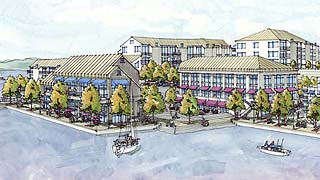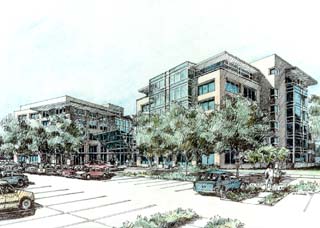
Surveys
DJC.COM
December 11, 2003
Northwest taps into waterfront properties
CollinsWoerman

Renderings by CollinsWoerman
Vulcan Inc.’s plans for the south Lake Washington waterfront include a mixed-use development called Quendall Landing.
|
In recent years, the Pacific Northwest has seen a major increase in port and waterfront property requiring master planning and redevelopment. Why now?
In general, costal regions across the country have seen an increase in people moving out of the suburbs and into the cities. There has also been a large migration from the “heartland” to coastal areas. With the influx in population and business activity has come a demand for new development.
As cities evaluate available property, many realize that underutilized waterfront land can be a major revenue generator. Because of this, many cities are beginning to seek out ways to capitalize on the incredible value and potential of their waterfront property.
With the help of the community and stakeholders, many cities have maximized profitability, revitalized neighborhoods and added value to their regions.
San Francisco and Baltimore are two recent examples of cities that have put significant resources into revitalizing waterfront property. After many years of hard work, Boston now has a waterfront area that is known as a premier place to live, work and play.
The Pacific Northwest's waterfront property has been largely unchanged for the past 20 to 30 years, as natural resource-based occupations dominated the area, and waterfront real estate was relied on to support these industries.
Today, everything is changing.
In the past eight years, CollinsWoerman has worked on master planning for a number of the region's largest waterfront projects, including Vulcan's Port Quendall and South Lake Union, Port of Seattle's Terminal 91 and Northbay, Georgia Pacific's redevelopment in Bellingham, Renton's Boeing property, Everett's waterfront redevelopment and North Macadam/Oregon Health Sciences University in Portland.

The Port Quendall project would also include a high-tech business park.
|
Each shoreline and port presents its own unique set of challenges. And the correct way to address these is by not implementing a cookie-cutter approach to waterfront planning.
Many will ask why a cookie-cutter approach is not the most efficient way to approach our region's waterfront redevelopment. After all, the design factors that worked in San Francisco's Mission Bay should work in Seattle, shouldn't they?
Historically, when addressing master planned work, the industry first comes up with a solution and then backs its way into the issues the solution is attempting to solve. As soon as the solution comes out, it polarizes the neighborhood it involves. Planners have alienated key constituents and the project fails because no one can agree on what the key issues are.
However, by tackling challenges head on and developing a customized solution unique to each project, value is added not only to the city and the stakeholders, but the region.
Realizing this, it is important to master plan waterfront development that not only satisfies the shareholder and community requirements, but also helps make the region competitive.
There are some overriding principles and issues that must be considered when beginning a waterfront revitalization project:
- Value creation — focusing all plans on generating an increase in the value of real estate so that it creates an economic engine to pay for improvements, amenities and increased infrastructure.
- Community evolution — recognizing where the community is at in its evolution and what is important today.
- Maximizing stakeholder value — designing to increase the economic value to stakeholders while creating a “win-win” environment where the community is helping to create a future.
A greater level of success is achieved by aligning key issues and taking time to meet and understand the goals and challenges of all project participants.
At the beginning of each project, CollinsWoerman gets community input to help the architectural team get a feel for local residents' issues and concerns. By doing so, the team can be adequately prepared to address participants concerns and incorporate solutions to them in its planning work.
These sessions typically yield information divisible into two categories:
- Issues alignment. Determine the issues the community faces and who the major stakeholders are. What are they trying to accomplish and why? Most people agree on the issues a community faces, however most do not agree on how to deal with them.
- Trade-offs. Once the issues have been identified, we develop a few viable solutions. This allows constituents to understand the economic parameters regarding value creation of Plan A and Plan B. After further examination, trade-offs can be determined. Some portions are mutually exclusive, but if the trade-offs can be determined, it becomes much easier to move forward and create a plan that the stakeholders and community members will support.
At this point, the architectural team is equipped to devise a master plan that not only addresses key constituents' concerns about the land, but provides ways to solve or improve them.
By truly understanding and facing each waterfront revitalization project as its own unique challenge, a plan can be devised that answers the major challenges and questions associated with the project.
If a master plan can answer key community questions, utilize property and add value to the community, it will become a place that not only serves the city, but makes the Pacific Northwest a better place.
Arlan Collins is a managing partner of CollinsWoerman. He has served as the firm's principal architect for several recent urban planning projects.
Other Stories:
- Insights Program looks at commercial real estate
- Grocery stores cooking up more innovations
- Retail chic: Shopping centers with meeting places
- Development is changing; training should be, too
- When the government takes your property
- Don't get fenced in: Use a land title survey
- Are you paying too much property tax?
- A new corridor may be coming down the Pike
- Columbia City — the next hot spot?
- Yakima Valley real estate heats up
- Town centers rediscovered after years of neglect
- Interest rate hike could mean time to sell
- David A. Sabey
- James N. Carbone
- John Solberg
- Mic Dinsmore
- Mark A. Weed
- Portland's economic Rx: a biotech future
- The recovery train has left the station: Are we on it?
- Are hotels overbuilt or just overproposed?
- Tax credit program boosts low-income communities
- Debt can be good for nonprofits' projects
Copyright ©2009 Seattle Daily Journal and DJC.COM.
Comments? Questions? Contact us.